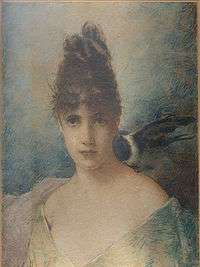Société Libre des Beaux-Arts
The Société Libre des Beaux-Arts ("Free Society of Fine Arts") was an organization formed in 1868 by Belgian artists to react against academicism and to advance Realist painting and artistic freedom. Based in Brussels, the society was active until 1876, by which time the aesthetic values it espoused had infiltrated the official Salon.[1] It played a formative role in establishing avant-gardism in Belgium.[2]

The first exhibition of the Free Society was held in 1868[3] to provide an alternative art space beyond the Salon. Three exhibitions were held in 1872.[4] The society's manifesto was written by Camille van Camp and published 31 January 1869. It promoted the "free and individual interpretation of nature" characteristic of Realist art, along with avant-garde concepts such as "struggle, change, freedom, progress, originality and tolerance."[5]
The society published the periodicals L'Art Libre, a bi-monthly review (1871–72), and L'Art Universel (1873–76). In the first issue of L'Art Libre, they collectively asserted:
Artistic independence must be spawned by force. It is our desire that art be free. The art of our time must return to man and nature.[6]
The goals of the Free Society were influenced by aesthetic ideals set forth by Gustave Courbet and the Barbizon artists and by the poet Charles Baudelaire. "Modernity" and "sincerity" were keywords.[7] Official cultural critics were at first openly hostile. Two early champions, however, were the critics Camille Lemonnier, a member, who urged that they should "be of their own time," and Théo Hannon (1851-1916), who saw them as rebels against artificiality.[8]
A group portrait by society member Edmond Lambrichs shows the 16 artists of the original organizing committee.[9] The society attracted in particular landscape painters working at the Atelier Saint-Luc of Brussels, also known as the Académie de Saint-Luc (ca. 1846–1864).[10] Louis Dubois, Félicien Rops, Constantin Meunier and Louis Artan de Saint-Martin are considered leading members.[11] Most of the society's members had also belonged to the Artistic and Literary Circle of Brussels and the Royal Belgian Society of Watercolorists.[12] After the society dissolved, several members joined groups such as La Chrysalide and Les XX.[13]
List of original members


- Edouard Agneessens
- Louis Artan de Saint-Martin
- Alphonse Asselbergs
- Théodore Baron
- Antoine-Félix Bouré
- Paul Jean Clays
- Marie Collart-Henrotin (1842-1911)
- Joseph Coosemans
- Charles de Groux
- Hippolyte de la Charlerie
- Louis Dubois
- Adrien-Joseph Heymans
- Edouard Huberti
- Edmond Lambrichs (1830-1887)
- Paul Lauters
- Camille Lemonnier
- Constantin Meunier
- Jules Raeymaekers
- Félicien Rops
- Eugène Smits
- Camille van Camp
- Henri Van der Hecht (1841-1901)
- Isidore Verheyden
- Alfred Verwee
The society expressed an internationalist desire by inviting Courbet, Corot, Charles-François Daubigny, Théodore Rousseau and Jean-François Millet to join as honorary members.[14]
See also
References
- Arto: Aperçus historiques Archived 2009-12-17 at the Wayback Machine
- Julius Kaplan, entry on "Société Libre des Beaux-Arts," in The Grove Dictionary of Art. From Renaissance to Impressionism: Styles and Movements in Western Art, 1400–1900 (St. Martin's Press, 2000), p. 343.
- Arto: Aperçus historiques.
- Grove, p. 343.
- Grove, p. 343.
- Avec force l'indépendance artistique doit éclore. Nous voulons que l'art soit libre. L'art de notre époque doit retourner à l'homme et la nature.
- Arto: Aperçus historiques.
- Grove, p. 343.
- Grove, p. 343.
- Arto: Aperçus historiques.
- Philippe Robert-Jones, The history of Painting in Belgium (Renaissance du Livre, 1995), p. 20.
- Cercle artistique et littéraire de Bruxelles and Société royale belge des Aquarellistes.
- Arto: Aperçus historiques.
- Grove, p. 343; William Orpen, The Outline of Art (W.H. Wise, 1934), p. 359.